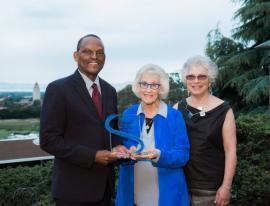Submitted by medium on Mon, 06/19/2017 - 16:03
“So, Bill, how’s the fight on pessimism going?”
The question was posed by Margaret Levi, director of the Center for Advanced Study in the Behavioral Sciences (CASBS) at Stanford University, near the end of her introduction of William Julius Wilson, recipient of the 2017 SAGE-CASBS Award and a 1981–82 CASBS fellow. Moments earlier, Levi had quoted a 2016 Harvard Gazette article in which Wilson described his struggle to fight pessimism in the face of only modest change in the social and economic circumstances of African Americans during his lifetime.
Coincidentally, just before the presidential election of 2016, Wilson’s colleague at Harvard University, Henry Louis Gates, Jr. (a 2007–08 CASBS fellow) asked him, for purposes of updating a television project, to weigh-in regarding his level of optimism or pessimism regarding the future of black Americans.
So, though a topic of concern for much of his career, the questions have weighed heavily on Wilson’s mind in recent months, in what he calls “a very frustrating period in our history.”
Aware of the opportunity presented him, Wilson meticulously offered responses to Levi and Gates throughout his SAGE-CASBS Award lecture, delivered at CASBS on June 8, 2017 to a rapt, overflow audience. The public event was presented by CASBS and SAGE Publishing. The SAGE-CASBS Award recognizes outstanding achievement in the social and behavioral sciences that advance our understanding of pressing social issues. It underscores the role of the social and behavioral sciences in enriching and enhancing public policy and good governance.
The Lewis P. and Linda L. Geyser University Professor at Harvard, William Julius Wilson is one of the most influential and path-breaking social scientists of the past half-century, and in particular one of the most accomplished scholars of race, inequality, and poverty. Among his numerous honors are the National Medal of Science, induction into the National Academy of Sciences, and 46 honorary degrees. His hefty 56-page CV, as Levi remarked, is “not packed with anything trivial.” In addition, as Levi detailed in her introduction, Wilson’s influence has extended beyond academics and even beyond politics and public policy debate, penetrating into the popular culture.
Wilson’s SAGE-CASBS award lecture, “Reflections on American Race Relations in the Age of Donald Trump,” put his well-earned stature and command of the issues on full display, both for attendees and C-SPAN, which filmed the event for later broadcast.
As Relevant As Ever, Regrettably
Wilson’s own classic works — including The Declining Significance of Race (1978), The Truly Disadvantaged (1987; partially written at CASBS), and When Work Disappears (1996) — established long ago that African Americans are not a monolithic social-economic group. Conditions have deteriorated for poor blacks and improved for more educated, skilled blacks. With updated data and figures, Wilson showed the audience that intra-group income inequality has risen more among black households relative to other groups and the U.S. population as a whole since 1970. Moreover, income inequality is related to income segregation, particularly in urban metropolitan areas. Compared with the 1970s, when income segregation among black families was relatively low, it has grown rapidly since 2000.
“When considering a person’s life trajectory or life chances, the differences in the quality of one’s daily life between residing in a predominantly affluent neighborhood and a poor black neighborhood are huge,” said Wilson. But when discussing such intra-racial differences, we must keep in mind that interracial disparities between blacks and whites remain substantial. The Great Recession only exacerbated this gap, conforming to the historical trend in which periods following downturns adversely impact blacks more than whites.
The intra-racial trends leave Wilson “somewhat optimistic” about the future of trained and educated blacks, but only in a qualified way, as indicators of children’s progress are associated not only with the social and economic status of their parents, but also their grandparents. This multi-generational “accumulation of disadvantages” — even for middle-income blacks — carry policy implications obvious to Wilson: race-specific but “flexible merit-based” affirmative action programs “will be required for the foreseeable future to ensure the continued mobility of educated blacks.”
But affirmative action programs, in the view of Wilson and others, are not really designed to address the problems of the most disadvantaged and poorest people of color. This leaves him decidedly and increasingly pessimistic about their futures.
In citing work that finds a strong association between residential segregation (comprised of racial segregation and income segregation) and racial achievement gaps, the key driver of the association is the proportion of students’ classmates who are poor, said Wilson.
“Indeed, a school’s poverty rate could be a proxy for general school quality — schools with high poverty rates may have fewer resources overall.” Though Wilson enumerated a number of factors that help explain the impact of concentrated poverty in urban public schools, he called for more research to clarify exactly how the variables are interrelated and their relative importance.
In addition, the 1970s relocation of industries from central cities, leading to cessation of black migration from the south simultaneously with the out-migration of higher-income blacks, resulted in depopulation and prolonged joblessness that persists today. This, according to Wilson, makes it difficult to sustain a basic “institutional resource base” or to achieve adequate levels of “neighborhood social organization.”
The bleak picture, helped somewhat but mostly hurt by recent urban gentrification movements, manifests most visibly in the disproportionate number of low-skilled black males — “one of the legacies of historical segregation and discrimination,” said Wilson.
This matters because high jobless rates among low-skilled black males is “very much connected” to high incarceration rates, unleashing a vicious cycle that further diminishes future employment prospects.
“Because the feelings many inner-city black males express about their jobs and job prospects reflect their plummeting position in a changing economy,” said Wilson, “it is important to link these attitudes with the opportunity structure — that is, the spectrum of life chances available to them in society at large.”
Of the many disadvantages of this predicament faced by urban ghettos, Wilson highlighted exposure to violent crime. A startling graphic, based on data from a 2015 study by Jennifer Hochschild and Vesa Weaver, showed that in 1978 poor blacks older than 12 were only marginally more likely than affluent blacks to be violent crime victims (45 and 38 per 1000 individuals, respectively); by 2008 that had shifted dramatically (to 75 and 23 per 1000).
While repeated acts of police brutality against blacks rightly arouse our consciousness and media attention, the trauma and pain that poor inner-city families — who largely seek more, not less, police presence — experience in public spaces also deserves our attention, noted Wilson. In a nod to his former student and UC Berkeley sociologist Loïc Wacquant, Wilson pointedly emphasized this systemic tragedy as “The Other Side of Black Lives Matter.”
Forward: Divisive vs. Inclusive
In September 2016, Donald Trump proclaimed that black communities were “in the worst shape ever,” suggesting they were a monolithic entity. Not true, as Wilson clearly demonstrated throughout the SAGE-CASBS Award lecture. More damaging, Wilson observed, was that “racial tensions and the expression of racial antagonisms seem to have increased after [Trump] decided to run for the presidency…” The spike in racial tensions, Wilson asserted, should come as no surprise:
“We must understand that racial antagonisms are products of situations — economics situations, political situations, and social situations. Average citizens do not fully understand the complex forces that have increased their economic woes — the declines in real family incomes, the rise in wage dispersion, changes in the global economy, industry relocation, etc. Economic insecurities create conditions that ‘are breeding grounds for racial and ethnic tensions,’ especially if exclusive populist messages exploit these fears.”
Trump, as Wilson and many others would argue, indeed exploited these fears in his successful presidential campaign. He captured notable support from white lower and working class populations with a divisive populist message. Senator Bernie Sanders put forth an alternative, more unifying populist economic message that resonated among some of the same population segments, but as a presidential candidate he did not advance beyond the primaries.
A much broader vision of inclusiveness — involving intergroup cooperation — that some are beginning to discuss in the election’s aftermath, actually was advanced by Wilson 18 years ago, in his 1999 book The Bridge Over the Racial Divide: Rising Inequality and Coalition Politics.
In that book, Wilson sought a constructive dialogue on how problems associated with the disappearance of work among certain segments of the population can be addressed. The dialogue, Wilson reviewed in his lecture, should not focus on inner-city neighborhoods in isolation, even though problems there clearly are more severe. Rather, a more general discussion should focus on the concerns that the poor, working, and middle classes of all groups share — including neighborhood crime, job security and unemployment, declining real wages, skyrocketing housing and health costs, and affordable child care programs.
Moreover, as Wilson argued in 1999 and reiterated in his lecture, programs created in response to such concerns should be race-neutral.
Such programs inevitably “would disproportionately benefit the inner-city jobless poor, but also benefit large segments of the remaining population, including the white population,” said Wilson.
Too often seen as adversaries, these groups “are potential allies in a reform coalition because they suffer from a common problem: economic distress caused by forces outside their control.” In Wilson’s estimation, the argument is as true today as it was in The Bridge Over the Racial Divide.
“And it is being repeated by some observers in the U.S. post-election analysis and debates, including those who maintain that the Democrats’ emphasis on identity politics — in attempts to mobilize people of color, women, immigrants, and the LGBT community — tended to ignore the problems of poorer white Americans.”
Particularly in the “age of Trump,” multiracial solutions to shared problems is more important than ever. We must reject a too-commonly-held view that race is just too divisive. Proponents of a “new vision” must realize that when political messages are tailored for one racial group, another racial group will reflexively draw back, and vice-versa.
The challenge, then, according to Wilson, is to identify issues and programs that concern the families of all racial and ethnic groups, so that people within those groups, in common cause, can “honestly perceive mutual interests and join in a multiracial coalition to move America forward.”
“I cling to this vision. I cling to this vision — in my efforts to overcome a feeling of deep pessimism about the plight of the inner-city poor.”
Wilson’s passionate, rousing conclusion brought the audience to its feet and was a tough act to follow. SAGE Publishing founder and executive chairman, Sara Miller McCune, approached the lectern and presented Wilson with the 2017 SAGE-CASBS Award plaque and check. Before doing so, she confessed she was “practically speechless, which hardly ever happens to me.”
The awarding complete, Miller McCune could only echo the sentiments undoubtedly shared by many who had just witnessed and experienced what she just had.
“I am just really, really thrilled to have heard this speech, and I will remember it always. Thank you.”
You also can view the above video on the CASBS YouTube channel.
View a photo gallery from the 2017 SAGE-CASBS Award event.
Read a press release announcing William Julius Wilson as recipient of the 2017 SAGE-CASBS Award.
View a promotional event flyer disseminated in advance of the SAGE-CASBS Award lecture.
Center for Advanced Study in the Behavioral Sciences

William Julius Wilson, Sara Miller McCune, & Margaret Levi
Read More Link:
